Drinking Wisely and Well: Valpolicella
Reply

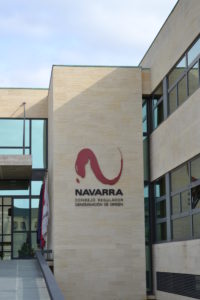 Situated in northern Spain, Navarra’s history stretches back to the Romans and includes close links to France, both in terms of its proximity to the country and the fact that the Count of Champagne, Theobald I, also held the title of King of Navarra. The region maintained its independence as a separate kingdom until it finally succumbed to the Castilian empire in 1512.
Situated in northern Spain, Navarra’s history stretches back to the Romans and includes close links to France, both in terms of its proximity to the country and the fact that the Count of Champagne, Theobald I, also held the title of King of Navarra. The region maintained its independence as a separate kingdom until it finally succumbed to the Castilian empire in 1512.
Coupled with this lengthy history is evidence (vinous vessels, called dolias, unearthed at Villa Romana de Arellano) that Navarran wine has been an important product from the very beginning.
Moreover, given Navarra’s place along the Camino de Santiago, it has been at the crossroads of many cultures for centuries. From the earliest days, pilgrims came from England, France, Germany and elsewhere throughout Europe, bringing their customs and cuttings as they passed through.
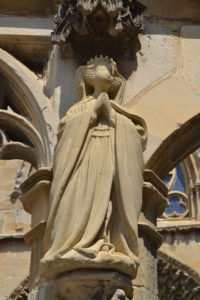 This heritage has infused Navarra and its wines with an international outlook and openness to trying new things, while still retaining its traditions. During a visit to the region in 2011, we saw an innovation with new winemaking techniques and experiments with novel grape varieties joined with an equally strong commitment to indigenous varieties.
This heritage has infused Navarra and its wines with an international outlook and openness to trying new things, while still retaining its traditions. During a visit to the region in 2011, we saw an innovation with new winemaking techniques and experiments with novel grape varieties joined with an equally strong commitment to indigenous varieties.
Navarra’s also wines speak to the lifestyle of the region. The town of Puente la Reina is bustling with activity as people sit outside at cafes and bars on a hot summer’s afternoon, perfect for ordering pinchos (tapas) and a bottle of rosé, which make up 25% of Navarra’s total production. The fresh and fruity wine is the perfect accompaniment to the heat of the day and the diversity of food on the table. Whites play a smaller role, but Chardonnay, Viura and, as of 2008, Sauvignon Blanc, can be found.
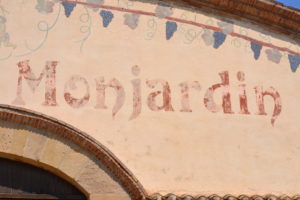 Bridging this duality of old and new, the well-worn and well-signed Pilgrim’s Path snakes its way past the medieval castle at Castillo Monjardin. With its eponymous winery, this family estate dates to the 12th century and is currently presided over by Sonia De La Lama and her husband, Victor. Planted to French as well as Spanish grape varieties, their vineyards underscore Navarra’s historical link to France, even though French varieties have only been permitted since the 1980s.
Bridging this duality of old and new, the well-worn and well-signed Pilgrim’s Path snakes its way past the medieval castle at Castillo Monjardin. With its eponymous winery, this family estate dates to the 12th century and is currently presided over by Sonia De La Lama and her husband, Victor. Planted to French as well as Spanish grape varieties, their vineyards underscore Navarra’s historical link to France, even though French varieties have only been permitted since the 1980s. 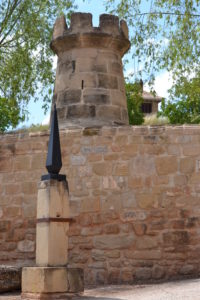
The region’s primary Spanish grapes include Tempranillo and Garnacha, the latter of which are often old vines, averaging 60 to 70 years old. The resulting wines are typically fresher and lighter than their Rhone Valley counterparts due to the area’s elevation and mountains, yet they have great concentration due to the vines’ age.
Another winery with deep roots in the region is Bodegas Nekeas, which traces its vineyards to the 17th century. However, the current configuration of the company dates to 1989 when the descendants of these original grape growers pooled their lands and replanted them, eventually building a winery in 1993.
With a much shorter tenure, Bodegas Príncipe de Viana was created in 1983, taking its cue from an historic Navarran title of Spanish royal succession dating to 1423. Despite its regal name, the winery was actually developed as a way to provide financial assistance to Navarra’s farming industry.
Overall, Navarran wines are easy to drink, food-friendly varietal wines with an emphasis on fruit character. Yet, what is most striking about these wines is their quality. In tasting one wine after another, there is concentration, complexity and beautiful balance in the glass. Even more amazing, most are priced under $20.00 and quite a few are under $15.00, with aged wines – those labeled as Crianza and Reserva – generally topping out at $30.00.
TASTING NOTES
Principe de Viana Chardonnay 2015, Navarra, Spain, $12.00
Although the label proudly acknowledges that the wine was barrel fermented, it is actually quite clean and fresh with only light oak/toothpick notes. Otherwise, it primarily displays aromas of melon, citrus and tropical fruit.
Principe de Viana Edicion Rosa 2015, Navarra, Spain, $15.00
This 100% Garnacha wine is refreshing with bright melon and peach fruit aromas and flavors, good acidity and long length.
Castillo de Monjardin La Cantera Garnacha 2015, Navarra, Spain, $11.00
A really lovely, light-bodied, fresh red with bright red fruits and long length.
Bodegas Nekeas Vega Sindoa Tempranillo 2015, Navarra, Spain, $10.00
Tart strawberry fruit aromas are joined by a slight woody note on the bright, medium-to-full bodied palate.
Morocco has a long and storied history, which includes being divvied up among France, Spain and the British until its independence in 1956. During France’s occupation, land was planted to wine grapes, which helped to quench the palates of thirsty Frenchmen. After their departure, many of the vineyards were abandoned, but today, the Moslem country still grows grapes and makes wine, although many Moroccans don’t indulge in alcohol.
Established in 1923, Domaine Ouled Thaleb is among the oldest Moroccan wineries in existence and helped lead the country’s renaissance in the 1990s. During this period, new vines were planted, with a continued emphasis on French grapes. Domaine Ouled Thaled currently practices organic farming and produces a range of wines, most of which are red, reflective of the country’s Mediterranean climate.
On the (relative) eve of our own departure for Morocco, we had the opportunity to taste two of their wines: Ouled Thaleb Signature 2013 (SRP $28.00) and Aït Souala 2012 (SRP $24.00). Both of these wines are blends, which bring together grapes from the AOG (Appellation of Origin Guaranteed) of Zenata, a coastal region that spans between the northeastern cities of Casablanca and Rabat.
We were very impressed with the Aït Souala, an interesting blend of Arinornoa, Tannat and Malbec. I had initially presumed that Arinornoa was Moroccan, but in fact, it is the result of a 1956 crossing of Merlot with Petit Verdot. So, not Moroccan, but created the same year as Moroccan independence and thus a fitting grape for its production there. This wine displayed aromas of candied cherry, slight herbs and slight wood notes, with the flavors of smoke and smoked meats – almost Syrah in nature – on the medium-bodied palate. It has low tannins, medium acidity and long length.
The Ouled Thaleb Signature brought together Carmenere, Marselan and Petit Verdot, aged for 14 months in barrel along with another 10 months aging in bottle. It has a pronounced nose with spices and dried herbs that persisted on the palate, along with medicinal and earthy notes, which we attributed to brett*. I don’t know if our displeasure with this wine was specific to this bottle or indicative of the wine and I was unable to find alternate reviews to see if our opinion had been shared.
In general, this winery garners praise for its wines, so if you come across them in your local store, I would suggest giving them a try. I was pleasantly surprised how well balanced and elegant the wines were; I expected a much more fruit-forward style given my pre-travel impressions of the country. It will be interesting to see what I think of the other Moroccan wines we encounter on our travels this month.
*Brett (or more correctly, brettanomyces) is a naturally occurring yeast that can add a complexity to the wines, but is controversial as to whether or not it is a flaw in the wine or not.
NB: These wines are distributed by Nomadic Distribution in California and also appear to be available through VOS Selections.
http://issuu.com/tracyellenkamens/docs/drink_wisely_and_well_return_to_rou?e=9398511/35346933
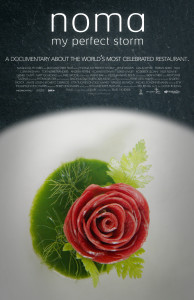 René Redzepi is not a household name, but for those in the culinary know, he is the bright star behind Copenhagen’s Noma restaurant. A new documentary from Magnolia Pictures, Noma: My Perfect Storm, inspired by Redzepi’s own books on the subject, charts his rise, fall and rise again.
René Redzepi is not a household name, but for those in the culinary know, he is the bright star behind Copenhagen’s Noma restaurant. A new documentary from Magnolia Pictures, Noma: My Perfect Storm, inspired by Redzepi’s own books on the subject, charts his rise, fall and rise again.
Scoring a reservation at Noma is a feat. Most of us won’t have the opportunity to dine at San Pellegrino’s Best Restaurant in the World (2010, 2011, 2012, 2014), but through this film, we can catch a glimpse of what it might be like to taste through the multi-course meal as imagined and conceived by this food fanatic.
In this regard, Redzepi is credited with creating a new concept — the Nordic kitchen – using Nordic ingredients almost exclusively, an especially daunting task considering that Scandinavia is blanketed by snow five months a year.
As part of developing this concept, he was determined to tell a story with each dish: the story of a place (where the food came from) and time (the season in which it was grown). In essence, the here and now of what is on the plate. With the use of time lapse photography, we are drawn through the seasons of the beautiful Danish landscape, further illustrating Redzepi’s pursuit.
To accomplish his ground-breaking approach (sometime quite literally), Redzepi combed the land for foragers, farmers and fishermen in search of local products, produce and people, many of whom we meet in the film. He claims that ingredients are an alphabet by which to share a new language; the more ingredients one has, the more beautiful the prose.
Beyond taste, Redzepi also explores new techniques such as his experiments with fermentation; fights about thyme vs lemon thyme; and inclusion of live ants in a particular dish. Aided by a head-mounted camera, we watch Redzepi’s creations come to life, accomplished with such tools as paint brush and tweezers to ensure that his vision is realized in its precise level of detail.
But, more than just a pretty picture of food, the film is refreshingly candid, permitting us to see not only the less than glamorous side of five-star dining, but also the darker side of Redzepi. Achieving such a lofty goal at a young age, Redzepi discusses the dangerous side of success. Moreover, it is evident that he takes things very personally and you can feel his frustration as he pushes himself and his team to be even more creative and constantly driven to be the best.
It is also an immigrant story. Born and raised in Macedonia on the family farm, Redzepi comes to Denmark as an outsider, who must overcome racism. Yet, as he advances his new Nordic menu, he is “more Danish than the Danes” as one of the film’s interviewees describes him. He must also overcome the derision of his peers who are less than enthusiastic about his novel menus and taunt him accordingly.
The film is a bit slow at times, but, ultimately, the story pulls you through, as you eagerly await the outcome of the various obstacles that Redzepi faces in his struggle to succeed.
Film from Magnolia Pictures
http://www.magpictures.com/noma/
Available in theaters, on demand, Amazon video and iTunes December 18, 2015.
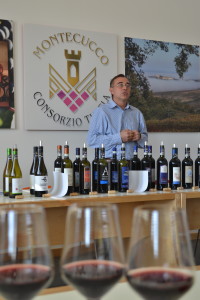 It could be the start of a bad joke: six journalists walk into a Consorzio office… wondering what in the world is Montecucco? But, instead, it was a pleasant journey that revealed another side of Sangiovese, a coterie of winemakers dedicated to their land and people passionate about wine.
It could be the start of a bad joke: six journalists walk into a Consorzio office… wondering what in the world is Montecucco? But, instead, it was a pleasant journey that revealed another side of Sangiovese, a coterie of winemakers dedicated to their land and people passionate about wine.
Situated within Italy’s Tuscany region, just south of Sienna, Montecucco abuts Morellino di Scansano and looks across the river to Brunello di Montalcino. Here, seven towns sheltered by Mt. Amiata, an extinct volcano, are making wine under the Montecucco designation.
While wine has historically been produced in the region, the denomination is quite young, having obtained recognition in 1998, thanks to the enterprising efforts of six producers. Previously, the area was known more for its polycultural approach to agriculture, with farmers growing not only grapes, but also olive groves and cereals and raising livestock, a practice which continues to this day.
But, despite its relatively recent arrival on the wine scene, Montecucco has seen significant growth in both numbers and quality and has been rewarded for its efforts. Since 2011, the denomination also sports a DOCG level wine and can boast that its yields are among the lowest in Italy at 7 tons per hectare for these top wines.
The DOC rules account for white, rosato and red wines. White wines are produced 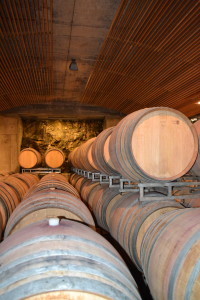 predominantly from Vermentino, with a minimum of 40% required for Montecucco Bianco DOC[1] and at least 85% of this variety for Montecucco Vermentino DOC.
predominantly from Vermentino, with a minimum of 40% required for Montecucco Bianco DOC[1] and at least 85% of this variety for Montecucco Vermentino DOC.
As elsewhere in Tuscany, Sangiovese is the grape of choice for reds. The Montecucco Rosso DOC requires a minimum of 60% Sangiovese, while the Montecucco Sangiovese DOCG must be produced with at least 90% Sangiovese. This latter wine and the Riserva also require 12 months and 24 months in wood, respectively, plus several months in bottle before release.
Given the area’s proximity to Morellino and Brunello, the wines almost beg to be compared and contrasted, in their description — more tannic than Morellino; less intense than Brunello. But, in reality, such an approach is much too limited and doesn’t provide the full picture.
Rather, the wines are truly capable of standing on their own merit and have their own distinct voice. This point was abundantly clear after we tasted through a selection of 24 wines at the consorzio office – our introduction to Montecucco. The wines were robust expressions of Sangiovese with firm tannins, notes of dried red fruit, spice and cherries with structure, complexity and power.
Moreover, as we quickly learned, as a region made up of many small producers (there are presently 70), the stories behind these wines were equally revealing. While there were differences in individual wine styles from producer to producer, a unifying declaration of a fierce devotion to quality and love for the territory was evident during our visits. To wit, 55% of the producers subscribe to organic farming.
Colle Massari: A Gentle Giant
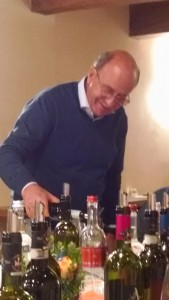 Perhaps the leading voice of the region is that of Claudio Tipa, President of the Montecucco Consorzio and owner of Colle Massari. Named for the hill on which it stands, Colle Massari is by far the largest producer in the region at 500,000 bottles per annum (of the region’s total annual production of 1.8 million bottles).
Perhaps the leading voice of the region is that of Claudio Tipa, President of the Montecucco Consorzio and owner of Colle Massari. Named for the hill on which it stands, Colle Massari is by far the largest producer in the region at 500,000 bottles per annum (of the region’s total annual production of 1.8 million bottles).
Tipa, a Tunisian-born Swiss who entered the wine industry after a successful career in telecommunications has built a portfolio of wine properties with his sister, Maria Iris, beginning with the purchase of Colle Massari in 1998.
Now also the owner of Grattamarco (in Bolgheri) and Poggio di Sotto (in Montalcino), Claudio admits that he entered the industry in a backwards manner by starting with a wine that was unknown in the market. Yet, despite this obstacle, and the allure of his other properties, his heart seems wedded to Montecucco.
Further, his commitment to Montecucco appears motivated by passion and not profit; Claudio proclaimed that, “We want to do something else – something smaller; something real. [Montecucco] is little and hidden. If you have Brunello, you can sell it. Montecucco is much harder [to sell].” In spite of Colle Massari’s relatively large size, his maintains a philosophy of staying small while keeping the quality high. His hard work and dedication have paid off, with Colle Massari earning Gambero Rosso’s Winery of the Year distinction in 2014.
Not surprisingly given his tenure and stature in the region, Claudio has served as president of the consorzio three times, but says that he won’t serve in that position again. Instead, he prefers to get the younger generation involved. In fact, he mentioned that he plans to retire at 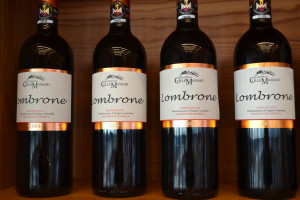 age 70. While I enjoyed the full collection of Colle Massari wines, I was particularly impressed with the Montecucco Riserva 2012, which displayed an impressive array of spice, cinnamon, black cherry, wet leaves, earth and olive notes.
age 70. While I enjoyed the full collection of Colle Massari wines, I was particularly impressed with the Montecucco Riserva 2012, which displayed an impressive array of spice, cinnamon, black cherry, wet leaves, earth and olive notes.
Perazzeta: Preserving the Past 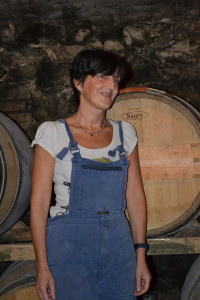 Another of the region’s early pioneers is Perazzeta. One of the founding members of the DOC, this small family business operates from a building that dates to 1400. The historic cellar was bombed during WWII because the Allies through the Germans were hiding there (they weren’t, but others were).
Another of the region’s early pioneers is Perazzeta. One of the founding members of the DOC, this small family business operates from a building that dates to 1400. The historic cellar was bombed during WWII because the Allies through the Germans were hiding there (they weren’t, but others were).
Similarly, the vineyard had been in the family for generations, providing wines for daily use. But, in 1994, the family was asked to bottle their wine by a Livorno restaurant, encouraging them to pursue a more commercial course for their wines. Today, their annual production runs 60-70,000 bottles.
In another nod to the past, the Bocci family has been working with a professor from Padua to research and identify old vines that have survived. As a result of this work, the winery’s Emma is produced from an extinct Sangiovese clone.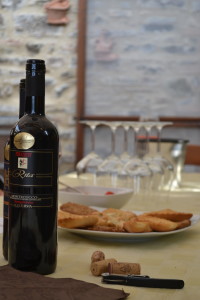
We were greeted at Perazzeta by Rita Bocci, wife of winemaker, Alessandro, who welcomed us dressed in denim overalls, underscoring the hands-on, down-to-earth nature of the people we met. More recently, they have been joined by their daughter, Sara, in the family business. Their Rita Riserva 2009 – named for both Alessandro’s wife and mother – was stunning with its beautiful development of spice, oak and cherry.
Prato al Pozzo: Yielding a Dream
 At Prato al Pozzo, we met Francesca Quiriconi, who owns the small estate with her husband, Fabio. The duo purchased the property in 2003 and have been slowly growing the estate. Fabio has served as director of two Antinori estates for many years and has always had a dream to produce his own wine.
At Prato al Pozzo, we met Francesca Quiriconi, who owns the small estate with her husband, Fabio. The duo purchased the property in 2003 and have been slowly growing the estate. Fabio has served as director of two Antinori estates for many years and has always had a dream to produce his own wine.
After ten years of waiting, they are finally building a real cellar, with construction appearing almost completed during the time of our visit. But, this dream has not come without its costs. Francesca manages the property in Fabio’s absence (he is only home on weekends) and is also responsible for taking care of their two daughters on her own.
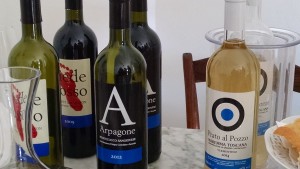 Named for a Molière character who was reluctant to spend money, their flagship wine is sourced from the initial Arpagone vineyard (1.5 hectares), which doesn’t yield very much. Although Francesca referred to this wine as a “poor cousin of Brunello,” it was really quite lovely with fresh cherries, earth, olive and mineral character. As they continue to establish themselves, they plan to grow to a maximum of 2.5 hectares and are in the process of converting to biodynamics.
Named for a Molière character who was reluctant to spend money, their flagship wine is sourced from the initial Arpagone vineyard (1.5 hectares), which doesn’t yield very much. Although Francesca referred to this wine as a “poor cousin of Brunello,” it was really quite lovely with fresh cherries, earth, olive and mineral character. As they continue to establish themselves, they plan to grow to a maximum of 2.5 hectares and are in the process of converting to biodynamics.
Poggio Mandorlo: Bringing Friends Together
Another realization of a dream, Poggio Mandorlo brought together four friends – Roberto, Felice, Giuseppe and Fabio – who wished to make their own wine. Accordingly, they came to the region in 2001, planting 30 acres of land under the direction of Consultant viticulturist, Maurizio Saettini, and initially hiring Brunello producer, Roberto Cipresso (of La Fiorita), as their consultant winemaker.
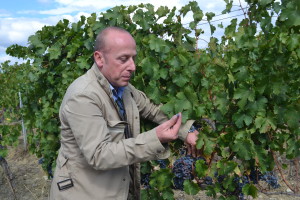 The estate sits 250 meters above sea level. Here, the mountains protect the vineyard from the Sirocco winds and stop the rain, while the good wind from the sea is able to penetrate and benefits the vines. With Sangiovese, Merlot and Cabernet Franc, the vineyard was carefully planted based on soil and exposure. Unlike Montalcino, which has no calcium in its soils, the Poggio Mandorlo estate is home to calcareous Albezza soils, similar to those found in Chianti Ruffina. The first vintage was in 2004.
The estate sits 250 meters above sea level. Here, the mountains protect the vineyard from the Sirocco winds and stop the rain, while the good wind from the sea is able to penetrate and benefits the vines. With Sangiovese, Merlot and Cabernet Franc, the vineyard was carefully planted based on soil and exposure. Unlike Montalcino, which has no calcium in its soils, the Poggio Mandorlo estate is home to calcareous Albezza soils, similar to those found in Chianti Ruffina. The first vintage was in 2004. 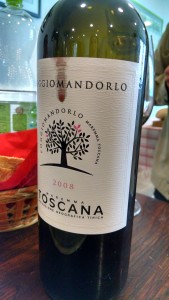
Their top wine, bearing the same name as the estate, is a blend of 70% Merlot and 30% Cabernet Franc, taking its cue from St. Emilion, despite its IGT Maremma Toscana designation. Given their north-facing exposure, the Cabernet Franc vines maintain good acidity and provide elegance to this wine, with its ripe fruit of red and black berries along with wet leaves and spice. Il Guardiano, their entry-level wine, previously qualified for Montecucco Sangiovese status, but with its 85% Sangiovese/15% Merlot blend, as of 2011 (the year of the new DOCG regulations), this wine is now labeled as IGT Toscana.
Poggio al Gello: A Labor of Love
With four hectares of grapes and five hectares of olives, Poggio al Gello 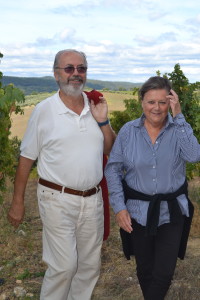 is a labor of love for a retired teacher (Alda) and engineer (Giorgio) who claim that they are continuing to work, but without the stress. The two are happy with their small size of 20,000 bottles annually and are proponents of organic agriculture.
is a labor of love for a retired teacher (Alda) and engineer (Giorgio) who claim that they are continuing to work, but without the stress. The two are happy with their small size of 20,000 bottles annually and are proponents of organic agriculture.
Recognizing that they needed schooling in the ways of wine, the couple hired the director of Col d’Orcia as their “teacher.” They note that he never tells them to do this or do that, but rather, is careful to explain to them why they should or shouldn’t do something. “He is our doctor of wine,” Alda says. Their Rosso del Gello Riserva 2011 spent two years in large oak, resulting in depth and complexity in the balanced and elegant wine.
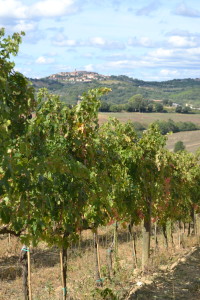 In addition to producing Montecucco wines, the estate makes two wines from ancient varieties – Pugnitello and Fogliatonda — as much as to preserve these nearly extinct varieties as because they don’t wish to be boring. Beyond wine, they also make their own olive oil. In fact, Alda seems to come alive in the olive grove, as she stops to admire the budding olives on the tree. In their spare time, he is writing a novel, while she plays the piano and recently wrote a song for their grandson.
In addition to producing Montecucco wines, the estate makes two wines from ancient varieties – Pugnitello and Fogliatonda — as much as to preserve these nearly extinct varieties as because they don’t wish to be boring. Beyond wine, they also make their own olive oil. In fact, Alda seems to come alive in the olive grove, as she stops to admire the budding olives on the tree. In their spare time, he is writing a novel, while she plays the piano and recently wrote a song for their grandson.
Tenuta l’Impostino: A Place to Stop and Rest
On a larger scale, Tenuta l’Impostino takes its name from the impostini — places where couriers would stop and change horses before heading on to their next destination during Medieval times. But, instead of moving on to the next location, the current owners fell in love with the area and decided to stay.
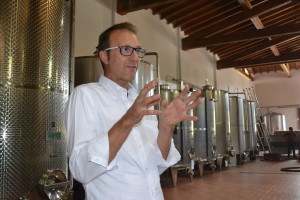 The 52 hectare property has 25 planted to vines, where a natural amphitheater provides excellent exposure. The old homestead’s restored farmhouse and stable presently serve as a restaurant and inn, respectively, providing a wonderful place for tourists to relax and recharge, while enjoying the estate’s wines.
The 52 hectare property has 25 planted to vines, where a natural amphitheater provides excellent exposure. The old homestead’s restored farmhouse and stable presently serve as a restaurant and inn, respectively, providing a wonderful place for tourists to relax and recharge, while enjoying the estate’s wines. 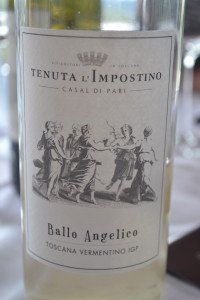
The first harvest was in 2006 and, in spite of the property’s size, the grapes continue to be hand harvested. Tenuta I’Impostino’s Vermentino, Ballo Angelico, was one of my favorite whites, with freshness, minerality and a touch of salinity. Their Montecucco Rosso 2011 was also really lovely, with cherries, earth and spice.
Parmoleto: The Family that Farms Together
As Leonardo Sodi meets us in his parking lot, he glances wistfully across the valley at Castello Banfi and Brunello territory, seemingly only a whisper away. Yet, he is resigned to his Montecucco fate and in keeping the family farm in the family.
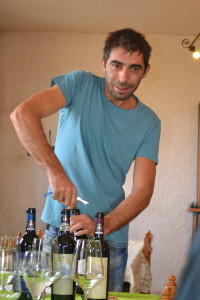 The 72 hectare estate consists of five hectares of vineyards, three hectares of olive groves and 65 hectares of cereals, along with 300 pigs and a bed-and-breakfast. The vines were mostly planted in 2000 and include just over 1 acre of Riesling.
The 72 hectare estate consists of five hectares of vineyards, three hectares of olive groves and 65 hectares of cereals, along with 300 pigs and a bed-and-breakfast. The vines were mostly planted in 2000 and include just over 1 acre of Riesling.
The Sodi family’s historic cellar is 100 years old, but his parents only starting bottling wine in 1990 and were among the six founders of the DOC. Today, they produce seven different wines, with a total annual production of 23,000 bottles. The intention is to maintain the current size of production because Leonardo is determined to keep it a family farm. If it becomes too large, it will not be a family farm.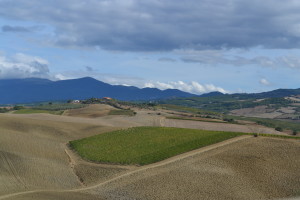
A sparkling wine and full-bodied white round out the predominantly red portfolio, but a rosato is noticeably absent because as Leonardo explains, he doesn’t like rosé. Although it needed more time to resolve its tannins, the Montecucco Sangiovese Riserva 2010 was balanced and elegant with tart cherry, spice and wood. His Sormonno, a blend of 75% Sangiovese and 25% Cabernet Sauvignon, displayed power and structure along with minerality and spice and was fondly dubbed a “Super Cucco” by fellow journalist, Dave Eckert.
Campo Nuovi: Breathing New Life into New Lands
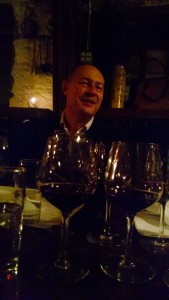 I first met Daniele Rosellini when I visited Chianti Classico in 2011; the agronomist had been instrumental in the Chianti Classico 2000 research in which the best grape varieties, clones and rootstocks were identified as part of Chianti Classico’s commitment to improving quality. During this time, Daniele and his wife, Nadia Riguccini, wished to craft their own wines, but they needed to stay outside the Chianti Classico territory to avoid a conflict of interest with his job.
I first met Daniele Rosellini when I visited Chianti Classico in 2011; the agronomist had been instrumental in the Chianti Classico 2000 research in which the best grape varieties, clones and rootstocks were identified as part of Chianti Classico’s commitment to improving quality. During this time, Daniele and his wife, Nadia Riguccini, wished to craft their own wines, but they needed to stay outside the Chianti Classico territory to avoid a conflict of interest with his job.
After much consideration, they purchased property 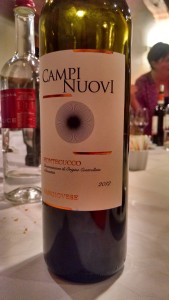 within the budding Montecucco denomination in 2000 with the goal of creating their own venture. Their land was previously referred to in historic documents as “Campi Nuovi” (New Fields), a name they kept as they thought is fitting to begin their “new life.” Today, their property is Certified organic and they are also practicing biodynamics. I didn’t have the opportunity to visit his estate during this trip, but it was a lovely surprise and pleasure to become reacquainted with him and to taste his wonderful wine. His Montecucco Rosso 2012 was powerful, concentrated and full of intense, dark red fruit, with slight notes of spice and vanilla.
within the budding Montecucco denomination in 2000 with the goal of creating their own venture. Their land was previously referred to in historic documents as “Campi Nuovi” (New Fields), a name they kept as they thought is fitting to begin their “new life.” Today, their property is Certified organic and they are also practicing biodynamics. I didn’t have the opportunity to visit his estate during this trip, but it was a lovely surprise and pleasure to become reacquainted with him and to taste his wonderful wine. His Montecucco Rosso 2012 was powerful, concentrated and full of intense, dark red fruit, with slight notes of spice and vanilla.
In Montecucco, Sangiovese speaks loudly and proudly; those tasting these wines will be rewarded with beautifully balanced, well-made wines. But, it is the voices of the people I met that linger with me still.
[1] Alternately, the Montecucco Bianco can contain a minimum of 40% Trebbiano Toscano.
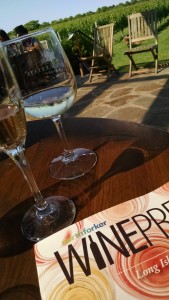 There is something special about visiting an island. The discrete borders, the intimate setting and the separation from the mainland all conspire to conjure images of a serene paradise. It’s why “Island Getaway” makes a much better headline than “Landlocked Getwaway”!
There is something special about visiting an island. The discrete borders, the intimate setting and the separation from the mainland all conspire to conjure images of a serene paradise. It’s why “Island Getaway” makes a much better headline than “Landlocked Getwaway”!
This summer, I had the pleasure of visiting several different islands, either in body (Long Island) or in spirit (Sicilia and Santorini), open to their charms through the lovely wines that are produced on each.
Close to home (aka New York City), Long Island provides a welcome refuge for city dwellers, with its beaches, farms and vineyards. We returned to the region after a two-year, accidental hiatus, stopping at some of our favorites for a brief refresher and to stock up our cellar, which we were about to deplete as a consequence of hosting our Meet, Meat & Merlot dinner, featuring a selection of aged Long Island Merlots.
The four-course dinner, held at our apartment, was an excellent opportunity to see how Long Island Merlot can develop with time. All of the wines, from the youngest at 12 years old (2003) to the oldest at 23 (1992), proved the point in spades. Between the chaos of cooking an elaborate menu and hosting 11 guests, I admittedly did not take notes on the wines, but the menu and wine selection are listed below.
Tasting notes for the various wines we tasted during our two-day visit to both the North Fork and The Hamptons AVAs are also included below.
Meet, Meat & Merlot Dinner Menu & Wines
Amuse Bouche: Frico Cheese Crisps with Hungarian Paprika
Wild Caught Salmon Sliders with Sage on Crispy Potato “Buns”
Shinn Estate Vineyards Estate Merlot 2003, North Fork of Long Island, USA
Shinn Estate Vineyards Six Barrels Reserve Merlot 2002, North Fork of Long Island, USA
¯
Coq au Vin 8 Hands Farm Organic Chicken Breast with Cipollini Onions & Mushrooms Lenz Estate Selection Merlot 2001, North Fork of Long Island, USA
Lenz Estate Selection Merlot 2000, North Fork of Long Island, USA
¯
Beef Wellington Organic Beef Tenderloin with Mushroom Duxelles and Foie Gras in Puff Pastry served with North Fork Squash and Sugar Snap Peas
Macari Vineyards, Bergen Road 1997, North Fork of Long Island, USA
Rivendell, Merlot 1990, North Fork of Long Island, USA
Rivendell, Merlot 1992, North Fork of Long Island, USA
¯
Dessert
Briermere Farms Raspberry & Peach Pie and
Briermere Farms Gooseberries and Wickham’s Farm Cherries
MACARI VINEYARDS
Macari Sauvignon Blanc 2014, North Fork of Long Island (NY), USA, $23.00
This wine is fresh and bright, with crisp citrus, a hint of green apple and long length.
Macari Dos Aguas Blanc 2013, North Fork of Long Island (NY), USA, $27.00
A blend of Chardonnay, Riesling, Viognier and Sauvignon Blanc. The intense nose displays aromas of lush pear and tropical fruit, both of which persist on the palate.
Macari Sauvignon Blanc No. 1 2013, North Fork of Long Island (NY), USA, $27.00 Macari has been actively experimenting with the use of concrete eggs and 60% of this wine was fermented in one. Compared to the regular Sauvignon Blanc, it was much rounder with lots of orange peel aromas and flavors.
Macari Cabernet Franc Lightforce 2013, North Fork of Long Island (NY), USA, $N/A
This wine was also fermented and aged in a concrete vessel. It was fresher and lighter than regular Cabernet Franc, but still very Cab Franc in its characteristics, with beautiful earth and mushroom notes.
Macari Merlot Reserve 2010, North Fork of Long Island (NY), USA, $36.00
From the near perfect 2010 vintage, this wine is absolutely gorgeous with rich notes of coffee and black cherry, culminating in long length.
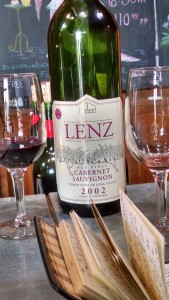 LENZ ESTATE
LENZ ESTATE
Lenz Estate Blanc de Noir Rosé 2013, North Fork of Long Island (NY), USA, $22.00
A light and pleasing rosé with fresh strawberry and slight herbal notes on the nose and palate.
Lenz Estate Old Vine Gewürztraminer 2010, North Fork of Long Island (NY), USA, $30.00
More floral than spice, this dry Gewurztraminer is quite elegant with nice acidity.
Lenz Estate Malbec 2011, North Fork of Long Island (NY), USA, $35.00
With intense and concentrated aromas of smoke, mulberry and blue fruit, this wine is more restrained on the palate, with elegant flavors of spice and blue fruit.
Lenz Estate Old Vines Cabernet Sauvignon 2002 North Fork of Long Island (NY), USA, $NA
This wine was showing some development with complex aromas and aromas of red fruit, black fruit and some meatiness. On the dry palate, it displayed ripe and concentrated flavors of blackberry, coffee and slight cedar; lovely.
McCALL WINES
McCall Pinot Noir 2012, North Fork of Long Island (NY), USA, $28.00
This wine offers fresh, bright fruit with notes of cherries, herbs and earth.
McCall Pinot Noir Hillside 2013, North Fork of Long Island (NY), USA, $39.00
This Pinot Noir is more complex and intense than the entry-level wine, with more meaty and spice notes.
McCall Merlot Reserve 2010, North Fork of Long Island (NY), USA, $30.00
This pretty and elegant wine displays rich black cherry aromas that pervade the palate as well.
McCall Ben’s Blend 2010, North Fork of Long Island (NY), USA, $54.00
Bringing together, Merlot, Petit Verdot, Cabernet Sauvignon and Cabernet Franc, this Bordeaux-style blend provides velvety tannins and nice complexity with gorgeous black fruit aromas and flavors.
CHANNING DAUGHTERS
Channing Daughters Tocai Mudd Vineyard 2012 North Fork of Long Island (NY), USA, 24.00
A combination of minerality and salinity greet the nose, while the palate is rewarded with apple and mineral notes and long length.
Channing Daughters Rosato di Refosco 2014, The Hamptons (NY), USA, $20.00 This rosé is distinctly herbal with sour cherry and a hint of salinity that lingers throughout the finish.
Channing Daughters Envelope 2011, The Hamptons (NY), USA, $42.00
Produced from 62% Chardonnay, 28% Gewurztraminer and 10% Malvasia Bianca, which were co-fermented with ambient yeast on the skins, this wine offers up pronounced aromas of floral and spice. This wine is rich, with concentrated fruit flavors of floral and pear on the palate.
Channing Daughters Ribolla Gialla 2013, The Hamptons (NY), USA, $35.00
This wine displays rich aromas of honey and marzipan. Its palate is dry with flavors of honey and white flowers.
Channing Daughters Sculpture Garden 2011, The Hamptons (NY), USA, $30.00
A blend of Merlot, Teroldego and Blaufrankisch, this wine spent 22 months in oak and 18 months in bottle before release. It has soft tannins, with notes of cherries, cocoa, and spice, which persist through the long finish.
NB: While I don’t have precise tasting notes, we absolutely adored Channing’s range of VerVino Vermouths.
WÖLFFER ESTATE
Wölffer Estate Noblesse Oblige Extra Brut Sparkling Rosé 2011, The Hamptons (NY), USA, $54.00
This elegant sparkling wine was very yeasty on the nose, with flavors of berries and cream on the palate.
Wölffer Estate Rosé 2014, Long Island (NY), USA, $18.00
Considered among the official rosés of the Hamptons, this fresh, Provencal-style rose is the perfect wine for summer with its purity of melon and berry fruit and refreshing acidity.
Wölffer Estate Summer in a Bottle 2014, Long Island (NY), USA, $24.00
This white blend offered up ripe, lush fruit with flavors of floral, peach and pear.
Grapes of Roth Dry Riesling 2014, Long Island (NY), USA, $26.00
Produced by Wölffer’s winemaker and partner Roman Roth, this is classic Riesling with citrus, slight pith, mineral, just a hint of off-dry sweetness on the attack.
Wölffer Estate Descencia Botrytis Chardonnay 2012, Long Island (NY), USA, $40.00
A late-harvest Chardonnay dessert wine with medium-sweetness, this wine is beautifully balanced by its bright acidity along with notes of honey, spice and Asian pear, culminating in long length.
http://issuu.com/tracyellenkamens/docs/drink_wisely_and_well_fresh_look_at